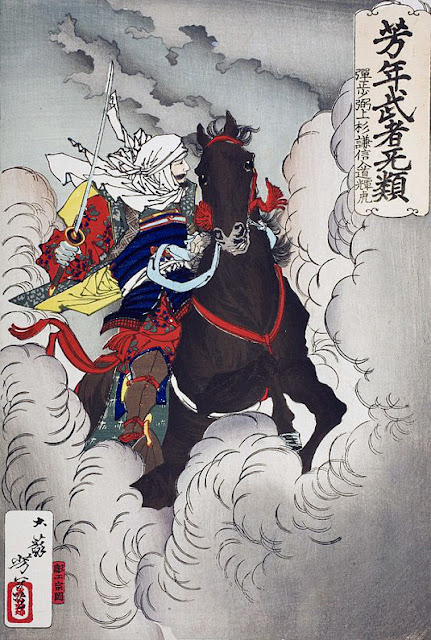 |
| Yoshitoshi: The Great Carp |
Tsukioka Yoshitoshi (1839-1892) is often considered as the last ukiyo-e master, although there are many bids on that epithet. However, he is one of the last, and one of the great geniuses of late ukiyo-e. He feels unmistakably modern.
Here we see "The Giant Carp" from the 1880s. The red figure is Kintarō.
Kintarō, a fictitious character, is probably based on a real person: Sakata Kintoki, from the Heian period (794-1185 AD). In Japanese folklore, however, he has grown to a superhero, a boy with superhuman strength. According to legend, he was raised by Yamauba (or Yamanba), a mountain hag on Mount Ashigara (or Mount Kintoki). There are several versions of his further story, some of them contradictory.
Still a popular figure in Japanese popular culture, Kintarō had his heydays during the Edo period, frequently appearing in traditional theater (both kabuki and nō) as well as in ukiyo-e.
In this woodblock print by Yoshitoshi, Kintarō is fighting against a great carp.




![Yoshitoshi: The lonely house on Adachi Moor [Adachigahara hitotsuya no zu] Ukiyo-e. Muzan-e. Adachi Moor. Yoshitoshi.](https://blogger.googleusercontent.com/img/b/R29vZ2xl/AVvXsEi8jx6CBehNENrnmeClg0ohDx0fs5cOQtCtx-Z4_FL36IMYJbGYbp1ZtMj8pqP0W4M2hDtNTKWUCivq1vJ3jFQYadmEDoRLJEQBwO8dj0RymykWIkHmngZy6IWVufX11gWBixdP0HrvzqW6/s640/Yoshitoshi+-+The+Lonely+House+on+Adachi+Moor+-+1885.jpg)
